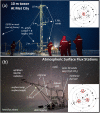Continuous observations of the surface energy budget and meteorology over the Arctic sea ice during MOSAiC
- PMID: 37542083
- PMCID: PMC10403539
- DOI: 10.1038/s41597-023-02415-5
Continuous observations of the surface energy budget and meteorology over the Arctic sea ice during MOSAiC
Abstract
The Multidisciplinary drifting Observatory for the Study of Arctic Climate (MOSAiC) was a yearlong expedition supported by the icebreaker R/V Polarstern, following the Transpolar Drift from October 2019 to October 2020. The campaign documented an annual cycle of physical, biological, and chemical processes impacting the atmosphere-ice-ocean system. Of central importance were measurements of the thermodynamic and dynamic evolution of the sea ice. A multi-agency international team led by the University of Colorado/CIRES and NOAA-PSL observed meteorology and surface-atmosphere energy exchanges, including radiation; turbulent momentum flux; turbulent latent and sensible heat flux; and snow conductive flux. There were four stations on the ice, a 10 m micrometeorological tower paired with a 23/30 m mast and radiation station and three autonomous Atmospheric Surface Flux Stations. Collectively, the four stations acquired ~928 days of data. This manuscript documents the acquisition and post-processing of those measurements and provides a guide for researchers to access and use the data products.
© 2023. Springer Nature Limited.
Conflict of interest statement
The authors declare no competing interests.
Figures
















References
-
- Stroeve J, Notz D. Changing state of arctic sea ice across all seasons. Environ. Res. Lett. 2018;13:103001. doi: 10.1088/1748-9326/aade56. - DOI
-
- Knust R. Polar Research and Supply Vessel POLARSTERN operated by the Alfred-Wegener-Institute. J. Large-scale Res. Facil. 2017;3:1–8. doi: 10.17815/jlsrf-3-163. - DOI
-
- Shupe M, et al. Overview of the MOSAiC Expedition: Atmosphere. Elementa: Sci. Anthro. 2022;10:00060. doi: 10.1525/elementa.2021.00060. - DOI
-
- Nicolaus, et al. Overview of the MOSAiC expedition: Snow and sea ice. Elementa: Sci. Anthro. 2022;10:000046. doi: 10.1525/elementa.2021.000046. - DOI
-
- Rabe, et al. Overview of the MOSAiC expedition: Physical Oceanography. Elementa: Sci. Anthro. 2022;10:00062. doi: 10.1525/elementa.2021.00062. - DOI
Publication types
Grants and funding
LinkOut - more resources
Full Text Sources

